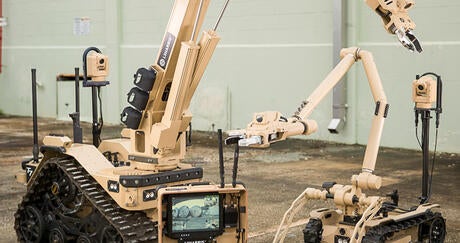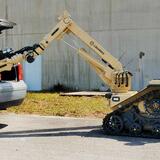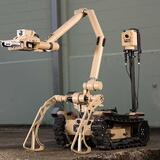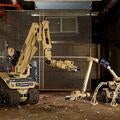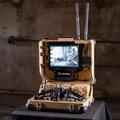Generally speaking, it is often the case that robotic systems operators are unwittingly held back from maximising on mission success. Throughout this article, we’ll be addressing six key areas in which operators are kept from realising their fleet’s full potential and explore how our large T7™ and medium-sized T4™ robots help to overcome this:
1. Reliability
Many robots within the market are simply not robust enough for the challenging environments in which they are set to work. For example, it’s surprising how frequently some robots are damaged due to rough handling, accidental drops, tipping over on uneven terrain, or colliding with objects when operating remotely. This can end up being extremely costly depending on how regularly replacement parts are required. Incredibly durable, our T7 and T4 robots do not fail often. In the rare cases that they do, they have multiple modes of failure recovery. One of our T4’s most unique capabilities is its ability to self-right at the press of a button thanks to omni-directional stabilizers. By quickly getting the robot back up and running should it ever tip over, mission success isn’t compromised and downtime is minimised.
Moreover, in a digital world where “turning it off and on again” is a go-to response in the event of an error, robotic systems operators will often seek the option to turn the robot’s capabilities on and off remotely to reboot the system should anything go wrong. Our T7 and T4 systems offer this, enabling operators to remotely cycle power to the robot’s subsystems in order to reset parts of the system mid-mission. This is also a really useful feature during missions where electronic countermeasures (ECM) are used concurrently with the robot. The robot can be “put to sleep” for a period of time, fully eliminating any Radio Frequency (RF) emissions and allowing the ECM team to characterise the RF environment and scan for threats. This “sleep” functionality has the added benefit of enabling a full restart of the robot remotely to aid in resetting system errors.
2. Capability
While an element of responsibility does lie with the operator to do a good job during a mission, a worker is only as good as the tools available to them. It goes without saying that if a robot is incapable of sufficiently completing the tasks it was procured to do, or is too complex for the operator to use confidently, it will negatively impact mission success. By instead procuring a robot that is designed for easy use and equipped with the right capabilities to tackle mission objectives, operators don’t need to work so hard, turning challenging tasks into manageable jobs.
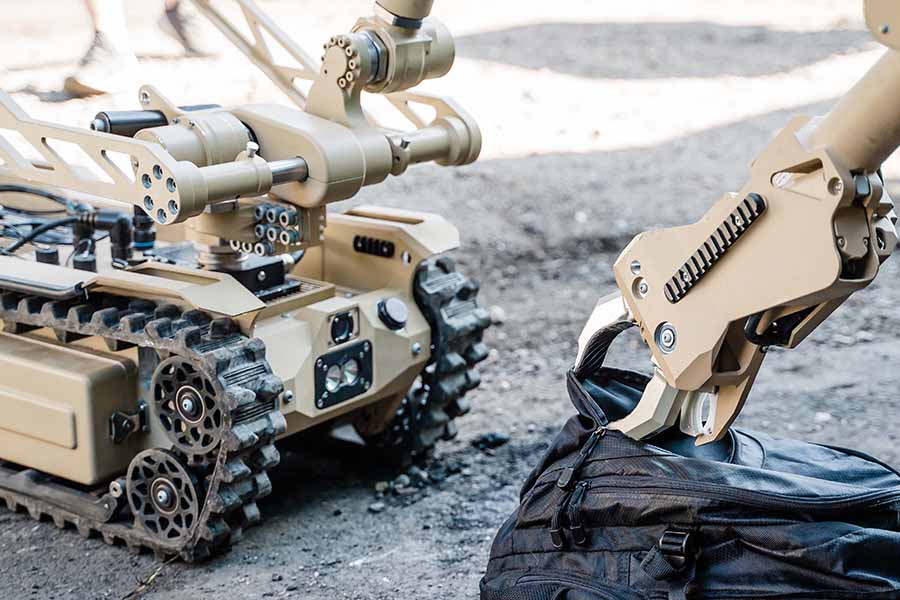
The common controller shared by our T7 and T4 robots harnesses intuitive haptic control which makes operating both systems a breeze. Its force feedback helps the operator to physically feel what the robot arm is feeling, vastly improving precision. We’re also working to incorporate several next-generation capabilities and attachments that will further enhance the operator’s experience. An increasingly sought-after capability is the option to fire different types of disruptor ammunition depending on the threat. Through multiple disruptor mounts and patented recoil-absorbing technologies both T7 and T4 are able to deploy a wide variety of recoiling and recoilless disruptors.
3. Situational awareness
Situational awareness plays a vital role during any mission. Put simply, if you’re unable to see the full scope of the environment you’re working in, your robot could be compromised by an unexpected obstacle or difficult terrain. That’s why seeking features such as an omni-directional camera can be critical. By enabling you to see in all directions around the robot, collisions are reduced, damage is minimised and a more complete picture of your surrounding environment is made possible. This also improves your search ability, enabling you to scan large areas quickly and thoroughly, ensuring maximum probability of threat detection.
We recently worked closely with one of our customers to implement an omni-directional 360-degree camera solution into their T7 robots. The customer was already aware of the benefits of 360-degree visibility from commercial camera systems so they wanted to improve their fleet’s situational awareness by adding this capability. After investigating the feasibility of achieving this and understanding the value such capability could offer the customer, we devised a solution that provided them with the visibility they needed. We even ensured this 360-degree view was available on a secondary display separate from the main controller, enabling operators to navigate missions as a team.
4. Speed of task completion
The importance of speed during a mission can vary depending on the type of threat. For example, if a timed device or time-sensitive dangers within a certain environment are involved then the priority is to get in and neutralize the threat as quickly as possible. Conversely, where the objective is to complete complex tasks as accurately and precisely as possible, speed may be less of a priority. In both instances, having a robot that’s as easy as possible to operate can make a huge difference.
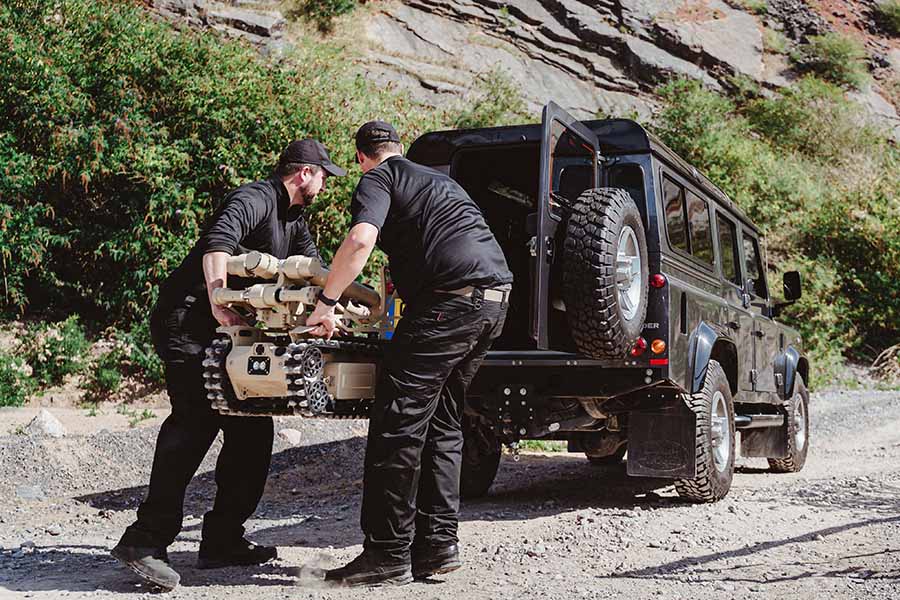
Our intuitive haptic controller enables human-like dexterity during challenging missions. This means even the most difficult of tasks can be completed with ease, accuracy, and speed, minimising task completion time and maximising mission effectiveness. Aside from control, speed also has big implications in other areas such as ease of deployment and boot-up time. The T7 and T4 take mere minutes to be powered up and spring into action, with our T4 able to be quickly broken down into subsystems and carried by two people for rapid deployment.
5. Training time
It can often be costly and time-consuming to train new operators to use robots, as inexperienced operators more frequently make mistakes that damage equipment, resulting in equipment downtime and expensive repairs. We’re helping customers to overcome this issue by collaborating with some of them on a virtual training system that will allow them to train operators to use a simulation-based T7. By connecting our haptic controller to the training system, we give operators a simulated environment that contains a virtual model of the robot that they can use in place of the real thing. This way, we achieve the best of both worlds as operators can gain familiarity with the real physical controls and interfaces of the system without placing any robot hardware at risk.
6. Collaboration
Maintaining a collaborative partnership with your robot supplier is crucial to ensuring your fleet consistently works as it should and is able to adapt to any evolving requirements. Keeping an open dialogue allows your supplier to quickly investigate and implement additional functionality or capability that could end up making a big difference to how you achieve mission success. This partnership is also important when it comes to troubleshooting any issues you might experience, particularly when you’re struggling to determine the root cause of the problem. If something isn’t working as expected, capture the information quickly by noting down the steps that led up to the issue and check in with your supplier, who should be able to advise whether an easy fix or if a lengthier examination is needed.
Our doors are always open to customers wanting to improve their fleet – it’s easy to come directly to us with a new requirement or for additional payloads, and we’ll readily provide a solution without a dramatic uplift in cost.
Experts at enhancing mission effectiveness
We work closely with our customers to ensure their robot fleet achieves exactly what they need it to. From adding 360-degree visibility to a virtual training system, we’re always on the lookout for new ways to enhance our T7 and T4’s capabilities in order to maximise mission success. In fact, our T7 was developed from the ground up to address and support the common challenges and demanding requirements of commercial and military missions.
Discover more about how our robotic systems help maximise mission success here.

